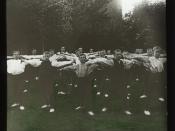Athletes with Eating Disorders
In a sense, eating disorders are diets and fitness or sports programs gone horribly wrong. A person wants to get fit, lose weight, excel in his or her sport, but then loses control and ends up with body and spirit ravaged by starvation, binge eating, purging, and frantic compulsive exercise. What may have begun as a solution to problems of low self-esteem has now become an even bigger problem in its own right. Eating disorders are significant problems in the worlds of ballet and other dance, figure skating, gymnastics, running, swimming, rowing, horse racing, ski jumping, and riding. Wrestlers, usually thought of as strong and massive, may binge eat before a match to carbohydrate load and then purge to make weight in a lower class.
The female athlete is doubly at risk for the development of an eating disorder. She is subject to the constant social pressure to be thin that affects all females in western countries, and she also finds herself in a sports climate that may overvalue performance, low body fat, and an idealized, unrealistic body shape, size, and weight.
Constant exposure to the demands of the athletic subculture added to those bombarding her daily on TV, in movies, in magazines, and transmitted by peers, may make her especially vulnerable to the lures of and unhealthy ways of achieving that loss.
Males also develop eating disorders but at a much reduced incidence (approximately 90% female; 10% male). Males may be protected somewhat by their basic biology and different cultural expectations.
Many sports demand low percentages of body fat. In general, men have more lean muscle tissue and less fatty tissue than women do. Males also tend to have higher metabolic rates than females because muscle burns more calories faster than fat does. So women,


